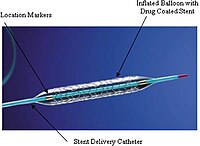
Photo from wikipedia
BACKGROUND Data regarding neoatherosclerosis after everolimus-eluting bioresorbable vascular scaffold (BVS) (ABSORB BVS Rev. 1.1, Abbott Vascular, Santa Clara, California) implantation are limited. OBJECTIVES This study investigated the findings of neoatherosclerosis… Click to show full abstract
BACKGROUND Data regarding neoatherosclerosis after everolimus-eluting bioresorbable vascular scaffold (BVS) (ABSORB BVS Rev. 1.1, Abbott Vascular, Santa Clara, California) implantation are limited. OBJECTIVES This study investigated the findings of neoatherosclerosis at 5 years after BVS 1.1 implantation by using multi-imaging modalities, including optical coherence tomography (OCT). METHODS Patients included in the ABSORB EXTEND (ABSORB EXTEND Clinical Investigation) trial at Shonan Kamakura General Hospital underwent OCT at baseline after the index procedure and at 1 and 5 years. Intimal plaque distributions in the in-scaffold and out-scaffold segments were analyzed. RESULTS Twenty patients (22 lesions) with stable angina pectoris were enrolled. The median follow-up duration was 67 months (interquartile range: 65 to 69 months), and the mean age was 69 ± 8 years. Patients with diabetes mellitus (25%) were included. Based on the baseline angiogram, 10 (46%) lesions were type B2/C lesions. At 1 and 5 years of follow-up, significant differences in the prevalence of in-scaffold lipid-laden neointima (17% vs. 61%; p = 0.04), calcification (28% vs. 94%; p < 0.01), neovascularization (6% vs. 78%; p < 0.01), and thin-cap fibroatheroma (0% vs. 22%; p = 0.02) were found. In the out-scaffold segments, no significant difference in the plaque prevalence between 1 and 5 years was noted. CONCLUSIONS The occurrence and progression of in-scaffold neoatherosclerosis with luminal narrowing was observed at 5 years after BVS 1.1 implantation. The small size of the current study warrants confirmation in larger study. (ABSORB EXTEND Clinical Investigation [ABSORB EXTEND]; NCT01023789).
Journal Title: Journal of the American College of Cardiology
Year Published: 2018
Link to full text (if available)
Share on Social Media: Sign Up to like & get
recommendations!